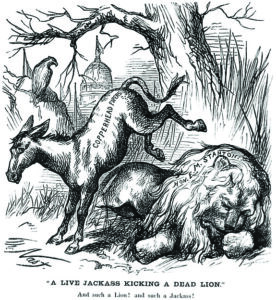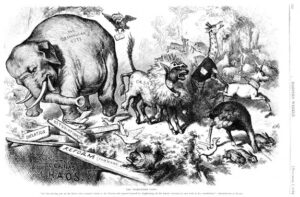FOR THE LOVE OF THE ANIMALS
By Beth Leermakers
How did the donkey and the elephant come to symbolize the Democratic and Republican parties? Thomas Nast, a Harper’s Magazine cartoonist from 1862-1886, was largely responsible, but the political origins of the donkey date back even further.

Photo courtesy of Smithsonian Magazine
During the 1828 presidential campaign, democrat Andrew Jackson’s opponents called him a jackass. Instead of being offended, Jackson was amused by the label and included the donkey in his campaign posters. Embracing the donkey as the symbol of his campaign, Jackson rebranded the donkey as steadfast, determined and willful, instead of wrong-headed, slow and obstinate. That year, Jackson defeated John Quincy Adams to become America’s first democratic president.
In 1870, Nast, a Republican who’s considered the father of the modern political cartoon, published the cartoon that associated the donkey with the Democratic party. In Nast’s cartoon, the donkey (representing a group of Northern Democrats known as “Copperheads”) is kicking a dead lion (representing President Lincoln’s recently deceased press secretary). This cartoon suggested the Copperheads, who opposed the Civil War, were dishonoring the legacy of Lincoln’s administration. Nast continued to use the donkey — a jackass — as a symbol representing (and disparaging) Democratic organizations.
Nast was also influential in establishing the elephant as the symbol of the Republican party. An elephant was featured as a Republican symbol in a political cartoon and newspaper illustration during the Civil War, when the expression “seeing the elephant” — meaning experiencing combat — was used by soldiers. The elephant became a GOP symbol when Nast used it in an 1874 Harper’s Weekly cartoon. Titled “The Third-Term Panic,” Nast’s drawing mocked the New York Herald, which had been critical of President Ulysses Grant’s rumored bid for a third term. The cartoon portrayed various interest groups as animals, including an elephant labeled “the Republican vote,” which was shown standing at the edge of a pit. Nast continued using the elephant to represent Republicans, and by 1880 other cartoonists were using the pachyderm to symbolize the party.
Both donkeys and elephants have lived at the White House. George Washington kept a donkey called Royal Gift (from the King of Spain, Charles III) on the White House grounds, along with several dogs, horses and a parrot (although the bird may have been Martha’s). Calvin Coolidge’s menagerie included a donkey named Ebeneezer, as well as a bobcat, an antelope, a wallaby, a pygmy hippo, some lion cubs, raccoons (named Rebecca and Horace) and several dogs, cats and birds. James Buchanan received a herd of elephants as a gift from the King of Siam (now called Thailand). Buchanan kept one of the elephants at the White House, along with his pair of bald eagles and his Newfoundland dog.

Just for fun, here are a few interesting (and apolitical) facts about donkeys and elephants:
Donkeys are intelligent creatures with impressive long-term memories. They can recognize other donkeys and animals — and even areas they’ve visited — for up to 25 years.
Donkeys’ stubbornness is attributed to their strong sense of self preservation. Their strong prey instinct and a weak connection with people make it difficult to frighten or force a donkey into doing something it perceives to be dangerous.
Donkeys’ exceptional hearing allows them to hear the call of another donkey 60 miles away! Their large ears also dissipate heat, helping them stay cool.
Donkeys are voracious eaters, consuming up to 6,000 pounds of food (grass, shrubs, plants) per year. They can go a long time without drinking water — making them well-suited for the desert. They can lose up to 30 percent of their body weight in water and regain it all by drinking for five minutes.
Elephants are highly intelligent, ranking up there with dolphins, apes and humans. Dolphins, apes and elephants are the only animals known to recognize their reflections in a mirror, a sign of self-awareness.
Elephants really do have a great memory. Elephants can recognize and keep track of the locations of as many as 30 members of their group at a time. They can even remember routes to alternate food and water sources when their usual spots dry up during a drought.
Elephant trunks are incredibly handy. Although they’re huge, weighing 400 pounds, an elephant’s trunk can pick up something as tiny as a single grain of rice. Elephants use their trunks for eating, drinking, smelling and communicating. Elephants spend 12 to 18 hours per day eating grass, plants and fruit.
Elephants have excellent long-distance hearing. Their ears, used in conjunction with the soles of their feet and their trunk, allow them to hear another elephant’s call from 2.5 miles away — or up to 6 miles, in ideal conditions. Their large ears also cool their body.
Despite their vastly different appearance, donkeys and elephants — much like Democrats and Republicans — share a few common traits that help them survive in challenging conditions. Let’s act like the animals and embrace those similarities, too.
